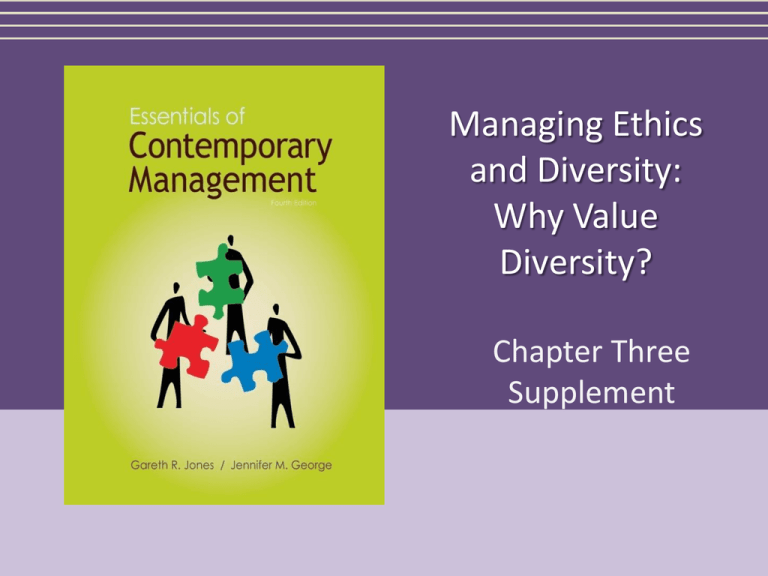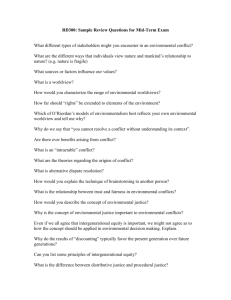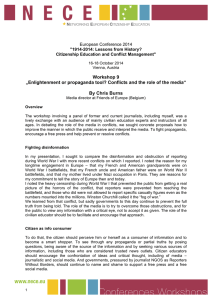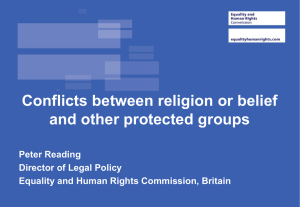Diversity - Oakton Community College
advertisement

Managing Ethics and Diversity: Why Value Diversity? Chapter Three Supplement Why Should We Value Diversity? “Over the last few years, it has become clear that organizations must pursue workplace diversity as a competitive necessity.” Jeffrey Gandz, Prof. Ivey School of Business, Canada 2-2 Competitive Advantage • What is a “competitive advantage?” • “Competitive advantage” gives a company an edge over its rivals and an ability to generate greater value for the firm and its shareholders. • The more sustainable the competitive advantage, the more difficult it is for competitors to neutralize the advantage. • http://www.investopedia.com/terms/c/competitive_advantage.asp#ixzz1yIjrjp00 2-3 Supplier Relationships • Can diversity be a competitive advantage? Whether buying goods and services in China, South America, India, etc. the ability to deal with suppliers in their own language, in appropriate behavioral manners, and to conduct successful negotiations may be critical dimensions of a competitive advantage. 2-4 Focus on Employees • Can diversity be a competitive advantage? • In an era of cutting-edge technology, organizations are finding that they must attract, retain, motivate and utilize valuable human resources effectively if they are to be competitive. Diversity in management and staff can reduce unwelcome turnover, reduce absenteeism and be a powerful magnet in recruitment. 2-5 Globalization • Can diversity be a competitive advantage? • As business is done more and more through partnerships, joint ventures and strategic alliances, an ability to relate to other cultures becomes a key organizational requirement. Organizations seeking global success will need high levels of diversity in their workforces. 2-6 Being a Good Corporate Citizen • There are both tangible and intangible benefits and costs associated with being a good corporate citizen and an organization's performance in developing a diverse workforce is one key element in obtaining such a profile. Diversity and Legal Costs • The United States and often other countries have to face the very real possibility of legal pressure and sanctions for non-compliance to jurisdictions. The Business Case for Diversity • • • • • • • • Anticipating and Responding to Customer Needs Supplier Relationships Innovation Globalization Diversity and Employees Being a Good Corporate Citizen Reducing Legal Costs Diversity and Society http://www.youtube.com/watch?v=ui4kjsWH-78 Laws & Regulations in the US • Thirteenth Amendment : Abolished Slavery 1865 • Civil Rights Acts 1866 and 1871 • Keating-Owen Act of 1916: child labor act • Equal Pay Act of 1963 • Title VII of CRA of 1964: protects individuals from discrimination based on race, color, sex, religion, national origin) • Age Discrimination in Employment Act of 1967 • Rehabilitation Act of 1973: expands Federal responsibility • Pregnancy Discrimination Act of 1978 • Americans with Disabilities Act of 1990 • Executive Order 11246 (i.e., requires affirmative action in hiring women and minorities) Microsoft http://www.youtube.com/watch?v=P3AbIGSIcMo Consequences of Diversity The Environment Conflicts Diversity Creativity http://www.youtube.com/watch?v=kNqWcsI0IRA&feature=related But, what about conflict...? • Mary Follett Parker pointed out long ago that: “..organizational wrestling with integrating diversity and difference should not count the number of conflicts but, instead, they should analyze the nature of the conflicts and how they are handled” (Brickson, 2000, p. 94). (1868 -1933) Causes of Conflict – Incompatibility of goals – Differences over interpretation of facts – Disagreements based on (behavioral) expectations and future behaviors – Differences in risk tolerance – Differences in time management – Differences in interests – Differences in political beliefs Different Types of Conflict 1. Traditional view of conflict 2. Human relations view of conflict 3. Interactionist view of conflict Traditional View of Conflict The belief that all conflict is harmful and must be avoided. Causes: • Poor communication • Lack of openness • Failure to respond to employee needs Human Relations View of Conflict The belief that conflict is a natural and inevitable outcome in any group. Interactionist View of Conflict The belief that conflict is not only a positive force in a group-but that it is absolutely necessary for a group to perform effectively. Functional vs Dysfunctional Conflict Functional Conflict Conflict that supports the goals of the group and improves its performance. Dysfunctional Conflict Conflict that hinders group performance. Types of Conflicts Relationship Conflict: – Conflict based on interpersonal relationships. Task Conflict: – Conflicts over content and goals of the work. Role Conflict: – A situation in which an individual is confronted by divergent role expectations. Process Conflict: – Conflict over how work gets done. Levels of Conflict 1. Intrapersonal or intrapsychic conflict (i.e., within an individual) 2. Interpersonal conflict (between individuals) 3. Intragroup conflict (among group members) 4. Intergroup conflict (between groups) Lewicki, Saunders & Barry (2003) Cognitions and Emotions and Conflict Perceived Conflict Felt Conflict Awareness by one or more parties of the existence of conditions that create opportunities for conflict to arise. Emotional involvement in a conflict creating anxiety, tenseness, frustration, or hostility. Conflict Definition Negative Emotions Positive Emotions Distrust Trust Examples of Moral Dilemmas • Being dishonest (“white lies”) • Use of illegal substances • Intervening in an emergency Finally, Why Value Diversity? Valuing diversity requires making accommodations for the needs, values, beliefs and lifestyles which will characterize a more diverse workforce








